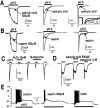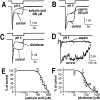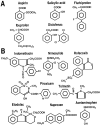Nonsteroid anti-inflammatory drugs inhibit both the activity and the inflammation-induced expression of acid-sensing ion channels in nociceptors
- PMID: 11588175
- PMCID: PMC6763876
- DOI: 10.1523/JNEUROSCI.21-20-08026.2001
Nonsteroid anti-inflammatory drugs inhibit both the activity and the inflammation-induced expression of acid-sensing ion channels in nociceptors
Abstract
Nonsteroid anti-inflammatory drugs (NSAIDs) are major drugs against inflammation and pain. They are well known inhibitors of cyclooxygenases (COXs). However, many studies indicate that they may also act on other targets. Acidosis is observed in inflammatory conditions such as chronic joint inflammation, in tumors and after ischemia, and greatly contributes to pain and hyperalgesia. Administration of NSAIDs reduces low-pH-induced pain. The acid sensitivity of nociceptors is associated with activation of H(+)-gated ion channels. Several of these, cloned recently, correspond to the acid-sensing ion channels (ASICs) and others to the vanilloid receptor family. This paper shows (1) that ASIC mRNAs are present in many small sensory neurons along with substance P and isolectin B4 and that, in case of inflammation, ASIC1a appears in some larger Abeta fibers, (2) that NSAIDs prevent the large increase of ASIC expression in sensory neurons induced by inflammation, and (3) that NSAIDs such as aspirin, diclofenac, and flurbiprofen directly inhibit ASIC currents on sensory neurons and when cloned ASICs are heterologously expressed. These results suggest that the combined capacity to block COXs and inhibit both inflammation-induced expression and activity of ASICs present in nociceptors is an important factor in the action of NSAIDs against pain.
Figures






Similar articles
-
Acid-sensing ion channels (ASICs): new targets for the analgesic effects of non-steroid anti-inflammatory drugs (NSAIDs).Curr Drug Targets Inflamm Allergy. 2004 Mar;3(1):71-9. doi: 10.2174/1568010043483980. Curr Drug Targets Inflamm Allergy. 2004. PMID: 15032643 Review.
-
Arachidonic acid potentiates acid-sensing ion channels in rat sensory neurons by a direct action.Neuroscience. 2007 Mar 16;145(2):686-98. doi: 10.1016/j.neuroscience.2006.12.024. Epub 2007 Jan 29. Neuroscience. 2007. PMID: 17258862
-
The role of the capsaicin receptor TRPV1 and acid-sensing ion channels (ASICS) in proton sensitivity of subpopulations of primary nociceptive neurons in rats and mice.Neuroscience. 2006 May 12;139(2):699-709. doi: 10.1016/j.neuroscience.2005.12.020. Epub 2006 Mar 3. Neuroscience. 2006. PMID: 16515841
-
Proinflammatory mediators, stimulators of sensory neuron excitability via the expression of acid-sensing ion channels.J Neurosci. 2002 Dec 15;22(24):10662-70. doi: 10.1523/JNEUROSCI.22-24-10662.2002. J Neurosci. 2002. PMID: 12486159 Free PMC article.
-
Acid-sensing ion channels (ASICs): pharmacology and implication in pain.Pharmacol Ther. 2010 Dec;128(3):549-58. doi: 10.1016/j.pharmthera.2010.08.006. Epub 2010 Aug 31. Pharmacol Ther. 2010. PMID: 20807551 Review.
Cited by
-
Diverse Physiological Roles of Calcitonin Gene-Related Peptide in Migraine Pathology: Modulation of Neuronal-Glial-Immune Cells to Promote Peripheral and Central Sensitization.Curr Pain Headache Rep. 2016 Aug;20(8):48. doi: 10.1007/s11916-016-0578-4. Curr Pain Headache Rep. 2016. PMID: 27334137 Free PMC article. Review.
-
Effect of diclofenac with B vitamins on the treatment of acute pain originated by lower-limb fracture and surgery.Pain Res Treat. 2012;2012:104782. doi: 10.1155/2012/104782. Epub 2011 Oct 31. Pain Res Treat. 2012. PMID: 22135737 Free PMC article.
-
Effect of endothelin receptor antagonist bosentan on chronic hypoxia-induced inflammation and chemoafferent neuron adaptation in rat carotid body.High Alt Med Biol. 2012 Sep;13(3):209-16. doi: 10.1089/ham.2012.1011. High Alt Med Biol. 2012. PMID: 22994521 Free PMC article.
-
Memory-enhancing effect of aspirin is mediated through opioid system modulation in an AlCl3-induced neurotoxicity mouse model.Exp Ther Med. 2016 May;11(5):1961-1970. doi: 10.3892/etm.2016.3147. Epub 2016 Mar 11. Exp Ther Med. 2016. PMID: 27168835 Free PMC article.
-
Upregulation of T-type Ca2+ channels in long-term diabetes determines increased excitability of a specific type of capsaicin-insensitive DRG neurons.Mol Pain. 2015 May 20;11:29. doi: 10.1186/s12990-015-0028-z. Mol Pain. 2015. PMID: 25986602 Free PMC article.
References
-
- Amara SG, Arriza JL, Leff SE, Swanson LW, Evans RM, Rosenfeld MG. Expression in brain of a messenger RNA encoding a novel neuropeptide homologous to calcitonin gene-related peptide. Science. 1985;229:1094–1097. - PubMed
-
- Brune K. Biodistribution of salicylates: a clue to the understanding of some effects and side effects. Agents Actions Suppl. 1977;2:163–177. - PubMed
-
- Brune K, Menzel-Soglowek S, Zeilhofer HU. Differential analgesic effects of aspirin-like drugs. Drugs. 1992;44 [Suppl 5]:52–59. - PubMed
Publication types
MeSH terms
Substances
LinkOut - more resources
Full Text Sources
Other Literature Sources
Molecular Biology Databases
